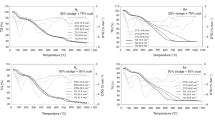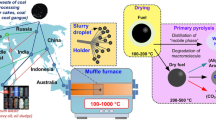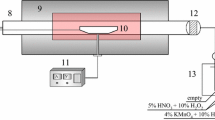Abstract
To realize the clean and efficient resource utilization of sewage sludge (SS) and coal slime (CS), single-component and coupled fuels were analyzed. The micro-characteristics of combustion products were analyzed using multiple characterization means. The structure–activity relationship between the physicochemical properties and the mercury emission characteristics of SS and CS during the complex and changeable co-combustion process was established. The influence of coupling multiparameter conditions on the mercury emission process was revealed along with the combustion characteristics and evolution process using a distributed activation energy model. The results showed that α-HgS, HgSO4 and HgO with α-type hexagonal structures are the main forms of inorganic mercury compounds contained in SS and CS. The pyrolysis and combustion process of the sample can be divided into three stages. In the SS combustion process, the activation energy increases first and then decreases with increasing conversion rate α, and the activation energy of CS shows a U shaped trend distribution. For the influence of O2 on the combustion and mercury emission process, a critical concentration exists between O2 concentrations of 5% and 7%, which dominates the pyrolysis and heterogeneous combustion of carbonaceous substances and volatiles. When the temperature is above 750 °C, the Boudouard gasification reaction occurs directly between CO2 and the sample in the semicoke state, promoting combustion and mercury emission processes. Due to the strong interaction between the SS and CS, the mercury emission during the co-combustion process of the coupled fuel is inhibited and promoted at 400–500 °C and 500–600 °C, respectively. The iron mineral components and fixed carbon in the sample play a catalytic role during the decomposition process of mercury-containing compounds that are difficult to decompose.
Graphical Abstract









Similar content being viewed by others
Data availability
The datasets generated and analyzed during the current study are available from the corresponding author on reasonable request.
References
Wang Y, Jia L, Guo J et al (2021) Thermogravimetric analysis of co-combustion between municipal sewage sludge and coal slime: Combustion characteristics, interaction and kinetics. Thermochim Acta 706:179056
Zhao R, Dai R, Chen T et al (2021) Investigation on combustion, gaseous pollutants emission and ash characteristics during co-combustion of semicoke and coal slime. J Environ Chem Eng 9:106249
Guo Y, Guo Y, Gong H et al (2021) Variations of heavy metals, nutrients, POPs and particle size distribution during “sludge anaerobic digestion-solar drying-land utilization process Case study in China. Sci Total Enviro 801:149609
Li JP, Hu YJ, Gan JH (2014) Present Situation on Resources Utilization of Sewage Sludge and its Potential Problems in China. Appl Mech Mater 448–453:756–760. https://doi.org/10.4028/www.scientific.net/AMM.448-453.756
Yu S, Tao R, Tan H et al (2023) Migration characteristics and ecological risk assessment of heavy metals in ash from sewage sludge co-combustion in coal-fired power plants. Fuel 333:126420
Liu T, Wen C, Zhou K et al (2023) Influence of collaborative disposal of sewage sludge in the fly ash partitioning and PM10 emission from a subcritical coal-fired boiler. Fuel 331:125871
Hao Z, Yang B, Jahng D (2018) Combustion characteristics of biodried sewage sludge. Waste Manag 72:296–305. https://doi.org/10.1016/j.wasman.2017.11.008
Lei K, Zhang R, Ye BQ et al (2018) Study of Sewage Sludge/Coal Co-Combustion by Thermogravimetric Analysis and Single Particle Co-Combustion Method. Energy Fuels 32:6300–6308. https://doi.org/10.1021/acs.energyfuels.8b00511
Wang W, Wen C, Liu T et al (2021) Emissions of PM10 from the co-combustion of high-Ca pyrolyzed biochar and high-Si coal under air and oxyfuel atmosphere. Proc Combust Inst 38:4091–4099. https://doi.org/10.1016/j.proci.2020.06.313
Guo S, Yang Q, Liang H et al (2019) Effect of blending sewage sludge with coal on combustion and ash slagging behavior. RSC Adv 9:29482–29492. https://doi.org/10.1039/c9ra04243a
Lee SS, Wilcox J (2017) Behavior of mercury emitted from the combustion of coal and dried sewage sludge: The effect of unburned carbon, Cl, Cu and Fe. Fuel 203:749–756. https://doi.org/10.1016/j.fuel.2017.04.104
Wang WL, Li B, Yao X et al (2019) Air pollutant control and strategy in coal-fired power industry for promotion of China’s emission reduction. Front Energy 13:307–316. https://doi.org/10.1007/s11708-019-0620-4
Jia L, Fan BG, Zheng XR et al (2021) Mercury emission and adsorption characteristics of fly ash in PC and CFB boilers. Front Energy 15:112–123. https://doi.org/10.1007/s11708-020-0682-3
Chen CX, Qin SH, Chen F et al (2019) Co-combustion characteristics study of bagasse, coal and their blends by thermogravimetric analysis. J Energy Inst 92:364–369. https://doi.org/10.1016/j.joei.2017.12.008
Li C, Wen C, Wang D et al (2022) Emission Characteristics of Gaseous and Particulate Mercury from a Subcritical Power Plant Co-Firing Coal and Sludge. Atmosphere 13:1656. https://doi.org/10.3390/atmos13101656
Chen L, Wen C, Wang W et al (2020) Combustion behaviour of biochars thermally pretreated via torrefaction, slow pyrolysis, or hydrothermal carbonisation and co-fired with pulverised coal. Renewable Energy 161:867–877. https://doi.org/10.1016/j.renene.2020.06.148
Jia L, Han F, Li Z et al (2021) Influence mechanism of additives on the crystal structure and desulfurization performance of magnesium slag. J Mater Cycles Waste Manag 23:1114–1125. https://doi.org/10.1007/s10163-021-01200-z
Liu T, Wen C, Li C et al (2022) Integrated water washing and carbonization pretreatment of typical herbaceous and woody biomass: Fuel properties, combustion behaviors, and techno-economic assessments. Rene Energy 200:218–233. https://doi.org/10.1016/j.renene.2022.09.073
Zhang XY, Zhu SJ, Zhu JG et al (2022) TG-MS study on co-combustion characteristics and coupling mechanism of coal gasification fly ash and coal gangue by ECSA (R). Fuel 314:123086
Magdziarz A, Wilk M (2013) Thermogravimetric study of biomass, sewage sludge and coal combustion. Energy Convers Manag 75:425–430. https://doi.org/10.1016/j.enconman.2013.06.016
Stelmach S, Wasielewski R (2008) Co-combustion of dried sewage sludge and coal in a pulverized coal boiler. J Mater Cycles Waste Manag 10:110–115. https://doi.org/10.1007/s10163-007-0206-9
Xu T (2017) Heat effect of the oxygen-containing functional groups in coal during spontaneous combustion processes. Adv Powder Technol 28:1841–1848. https://doi.org/10.1016/j.apt.2017.01.015
Jia L, Fan B, Huo R et al (2018) Study on quenching hydration reaction kinetics and desulfurization characteristics of magnesium slag. J Clean Prod 190:12–23. https://doi.org/10.1016/j.jclepro.2018.04.150
Zhou A, Wang X, Magdziarz A et al (2022) Ash fusion and mineral evolution during the co-firing of coal and municipal sewage sludge in power plants. Fuel 310:122416
Takaoka M, Oshita K, Okada M et al (2018) Mercury behaviour in flue gas from sewage sludge incinerators and melting furnace. WATER Sci Technol 77:782–790. https://doi.org/10.2166/wst.2018.268
Im H, Kim CG (2017) Characterization of dried sewage sludge for co-firing in coal power plant by using thermal gravimetric analysis. J Mater Cycles Waste Manag 19:1044–1051. https://doi.org/10.1007/s10163-016-0580-2
Yan YH, Sun LT, Peng ZK et al (2021) Effects of pyrolyzed semi-char blend ratio on coal combustion and pollution emission in a 0.35 MW pulverized coal-fired furnace. Front Energy 15:78–90. https://doi.org/10.1007/s11708-020-0678-z
Jia L, Fan B, Yao Y et al (2018) Study on the elemental mercury adsorption characteristics and mechanism of iron-based modified biochar materials. Energy Fuels 32:12554–12566. https://doi.org/10.1021/acs.energyfuels.8b02890
Ahmadi-Pirlou M, Gundoshmian TM (2021) The effect of substrate ratio and total solids on biogas production from anaerobic co-digestion of municipal solid waste and sewage sludge. J Mater Cycles Waste Manag 23:1938–1946. https://doi.org/10.1007/s10163-021-01264-x
Acknowledgements
This work was supported by the National Natural Science Foundation of China (No. U1810126), National Natural Science Foundation of China (No. U1910214), Project (SKLD21KM16) supported by State Key Laboratory of Power System and Generation Equipment, Fundamental Research Program of Shanxi Province (No. 20210302124449), and Shanxi Province Science and Technology Innovation Project of Colleges and Universities (No. 2020L0073).
Author information
Authors and Affiliations
Corresponding author
Additional information
Publisher's Note
Springer Nature remains neutral with regard to jurisdictional claims in published maps and institutional affiliations.
Supplementary Information
Below is the link to the electronic supplementary material.
Rights and permissions
Springer Nature or its licensor (e.g. a society or other partner) holds exclusive rights to this article under a publishing agreement with the author(s) or other rightsholder(s); author self-archiving of the accepted manuscript version of this article is solely governed by the terms of such publishing agreement and applicable law.
About this article
Cite this article
Jia, L., Cheng, P., Yu, Y. et al. Study on the co-combustion process and mercury emission characteristics of sewage sludge-coal slime coupled fuel. J Mater Cycles Waste Manag 25, 1369–1389 (2023). https://doi.org/10.1007/s10163-023-01612-z
Received:
Accepted:
Published:
Issue Date:
DOI: https://doi.org/10.1007/s10163-023-01612-z




